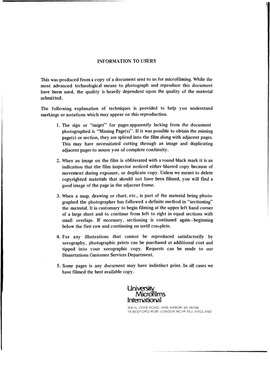| dc.contributor.author | O'neil, Charity Mary Rowland, | en_US |
| dc.date.accessioned | 2013-08-16T12:27:59Z | |
| dc.date.available | 2013-08-16T12:27:59Z | |
| dc.date.issued | 1980 | en_US |
| dc.identifier.uri | https://hdl.handle.net/11244/4705 | |
| dc.description.abstract | The development of five visually impaired infants between 10 months and three years of age was followed for six months. Films of mother-infant interactions were made in the subjects' homes at regular intervals throughout the six-month period to document the development of communicative skills within each dyad. The films were analyzed at 2-sec. intervals for seven categories of infant behavior and three categories of maternal behavior, comprising a total of 42 behavioral subcategories. Maternal behaviors were analyzed from the infant's perspective, so that only those maternal behaviors which could be sensed by a sightless infant were scored. The observational data were analyzed using lagged conditional probabilities to extract conditional relationships and cyclic dependencies among the scored behaviors. | en_US |
| dc.description.abstract | The results suggest that the infants' rates of communicative behavior were within normal limits. Furthermore, the rates of individual infant behaviors fluctuated cyclically over time. However, their behavior was notably unresponsive to maternal intervention. Maternal behaviors rates, on the other hand, changed frequently in response to infant behaviors, but did not display mutually cyclic patterns. Clinical implications include a greater emphasis on training parents in the appropriate patterning of their responses. A highly structured program of maternal response to infant vocalizations is suggested in the interest of enhancing the communicative use of vocalizations by the visually impaired infant. | en_US |
| dc.description.abstract | The infants showed serious deviations from the sequence of communicative development espoused by pragmatic language theorists. Several of the constructs that Elizabeth Bates considers strongly related to language development were absent in the one subject who acquired any linguistic ability during the project. These included the production of conventional, ritualized gestures, the notion of an external referent, and combinatorial and symbolic play (all of which would require visual guidance according to traditional definitions). These discrepancies suggest that the pragmatic model of language development, as traditionally operationalized, does not adequately describe communicative development in the visually impaired population. | en_US |
| dc.format.extent | xiv, 265 leaves : | en_US |
| dc.subject | Psychology, Developmental. | en_US |
| dc.title | Communicative strategies of visually impaired infants and their mothers. | en_US |
| dc.type | Thesis | en_US |
| dc.thesis.degree | Ph.D. | en_US |
| dc.thesis.degreeDiscipline | Department of Psychology | en_US |
| dc.note | Source: Dissertation Abstracts International, Volume: 41-02, Section: B, page: 0713. | en_US |
| ou.identifier | (UMI)AAI8016931 | en_US |
| ou.group | College of Arts and Sciences::Department of Psychology | |
